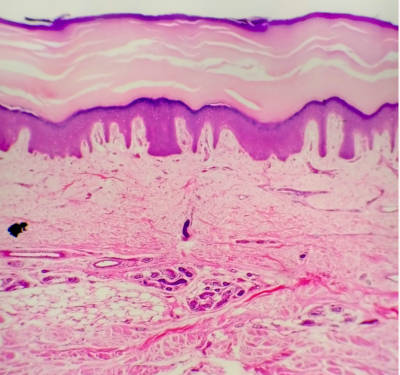Sweat is more than just “cool”
A review on the most prevalent type of sweat gland in the human body reveals that there is more to them than first meets the eye.
Published online 31 January 2016

Sweat glands in the skin may have more functions than previously thought.
© Garry DeLong / Alamy Stock Photo
For years, sweat glands were thought to be primarily involved in the regulation of body temperature. The eccrine gland is the most prevalent sweat gland in the human body and is highest in density in the skin of our palms, soles and forehead. It produces sweat in response to heat and exercise, but also in response to emotional stimuli such as fear, anxiety and pain. As sweat evaporates from the skin’s surface, the body’s temperature cools.
Weill Cornell Medical College in Qatar (WCMC-Q) physiologist Douglas Bovell says, in a review published in Global Local Health Science, that recent research shows these glands have other important functions as well1.
Eccrine glands were found, for example, to add to the skin’s defence mechanisms by producing an antimicrobial peptide called dermcidin, which restricts bacterial growth on the skin.
New sites have also been identified on sweat glands that can be used to limit or block sweat gland secretion. “This may prove useful in helping people who suffer from hyperhidrosis,” a disorder that presents with excessive sweating, “or in creating commercial opportunities for the development of new and more effective antiperspirants,” says Bovell.
Another study found that a group of athletes who produce sweat with a higher than normal salt content — known as “salty sweaters” — had a defective chloride channel in their eccrine glands. “In the sporting world, this finding may lead to a better understanding of thermoregulation in people and could lead to improved management of their performance,” says Bovell. Further research is needed to find out whether modern sports clothes designed to wick away sweat also remove beneficial antimicrobial components from the skin, he says.
Most recently, stem cells present in eccrine sweat glands were found to play an important role in renewing epithelial cells of the skin in response to wounds. More research could reveal ways to make use of these stem cells to create new sweat glands in burn victims and to improve wound healing in diabetes patients, for example.
“Further research into eccrine sweat gland function would provide a better understanding of its role, along with other skin appendages, in maintaining the skin throughout our life and in disease conditions as well as in understanding thermoregulation in greater detail,” says Bovell.Reference
- Bovell, D. The human eccrine sweat gland: structure, function and disorders. Glob. Local Health Sci.2015, 5 (2015). | article
DOI: 10.1038/qsh.2016.96

